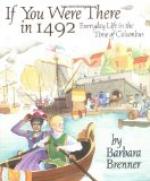[Footnote 16: Cape Cashepou is backed
by three peaked mountains, of
which a representation is given in Day’s
West Indies, vol 2, p. 31.]
The sailors sang the “Salve Regina,” with other pious hymns in honour of God and “Our Lady,” according to the custom of the mariners of Spain, who, in terror or in joy, were wont to find an expression for their feelings in such sacred canticles.
The pearl coast.
The admiral’s course, when he was going northwards, had been in the direction of the Carib islands, already well known to him; but with great delight he now turned towards Trinidad, making for a cape which, from the likeness of a little rocky islet near it to a galley in full sail, he named “La Galera.” [17] There he arrived “at the hour of complines,” but, not finding the port sufficiently deep for his vessels to enter, he proceeded westwards.
[Footnote 17: This point is sometimes
placed at the north-east of
Trinidad; but wrongly so. It is now
Cape Galeota.—See Humbolt’s Examen
Critique, vol. i. p. 310.]
[Illustration: Map of the pearl
coast. From about 50 miles west of the
island of Margarita to just east of Trinidad
and Tobago; from about 50
miles north of Grenada to 50 miles south
of the Orinoco River.]
First view of American continent
The first thing noticeable as he neared these shores, was that the trees grew well on the margin of the sea. There were houses and people,—and very beautiful lands, which reminded him, from their beauty and their verdure, of the gardens of Valencia as seen in the month of March. It was also to be observed that these lands were well cultivated.
On the following morning he continued in a westerly direction in search of a port, where he might take in water, and refit his ships, the timber of which had shrunk, from extreme heat, so that they sadly needed caulking. He did not find a port, but came to deep soundings somewhere near Point Alcatraz, where he brought to, and took in fresh water. This was on a Wednesday, the first of August. From the point where he now was, the low lands of the Orinoco must have been visible, and Columbus must have beheld the continent of America for the first time.[18] He supposed it to be an island of about twenty leagues in extent, and he gave it the somewhat insignificant name of Zeta.
[Footnote 18: The northern part of
the continent had been discovered by
Sebastian Cabot, on the 24th of June,
1497.]
The same signs of felicity which greeted his eyes on his first sight of land, continued to manifest themselves. Farms and populous places[19] were visible above the water as he coasted onwards; with the trees flourishing close to the sea—a sure sign of the general mildness of the weather, wherever it occurs.
[Footnote 19: “Vido muchas
labranzas por luengo de Costa y muchas
Poblaciones.”—Las
Casas, Hist. de las Indias, Ms., lib. i cap.
132.]




